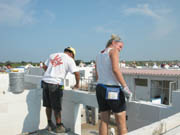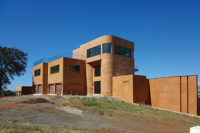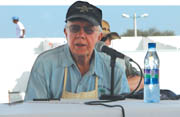
In the fall of 2004 the project set up shop in Mexico. It seemed ironic to some of the volunteers that we traveled from all over the United States to build homes in the birthplace of so many people who work hard every day building homes for us.
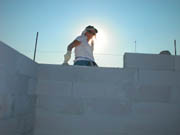
Habitat for Humanity and the 2004 Jimmy Carter Work Project
Millard and Linda Fuller founded HFHI in 1976 with the simple but daunting goal of eliminating all substandard housing from the planet. An organization with Christian roots and principles, Habitat does not give away houses. Instead, the organization seeks persons and families who cannot otherwise afford to buy a home of their own but are willing to work in partnership with Habitat and put in "sweat equity." They work several hundred hours on the construction of their home and the homes of others. Once their home is built, Habitat homeowners buy the home, which is sold to them at no profit by way of a no-interest mortgage.The 2004 JCWP consisted of two worksites in Mexico: Puebla and Veracruz. Puebla is situated in a mountainous region between Mexico City and the Gulf coast. Veracruz, located on the Gulf coast of Mexico, has an active port and serves as a vacation destination for the Mexican people. Plans called for the construction of 75 simple homes on each site, some freestanding, but most in clusters of three or four. According to Carter, who addressed the Latin American press and Mexican people in Spanish, the key differences in the two worksites were the terrain and the roofs. The roads were steep and the air was thin in Puebla, while the entire development in Veracruz was flat. And it was hot. The roofs and walls in Veracruz had much stronger ties due to their coastal location and susceptibility to hurricanes.
Speaking for himself and his wife, Carter stated that the JCWP is "not a sacrifice for us (but) a blessing." Paul Leonard, CEO of HFHI since June of 2004, thanked key sponsors of the project for what he termed, "another miracle," referring to the work of HFHI and previous Jimmy Carter Work Projects. Gustavo Gutievrez, director of HFH Mexico, says that having the JCWP in Mexico, "makes us visible." HFH Mexico has been in business for 14 years, and has built 14,300 homes through June 2004. Gutievrez is spearheading an aggressive campaign to build another 7,000 homes over the course of the next three years. The JCWP was visible in the national media of Mexico for much of the weeklong event.
The author had the honor of traveling to the JCWP with several dozen Habitat volunteers from around Georgia, Florida, Washington, D.C., and Montreal (Mark Butler's gang). These veterans, like many others, provided leadership for the volunteers working on the site. They were assigned to work on homes in Veracruz. The style of homes and construction was anything but familiar, but the basic concepts of organization around a plan and safe worksite practices were the same as every JCWP they had worked on in the past. The last time most of this group saw masonry construction was 2002 in South Africa.
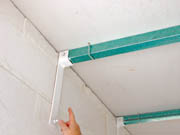
Let the building begin
The design of Habitat homes is based on local conditions and requirements. The homes built in Veracruz were actually a bit larger than the standard home built by HFH Mexico. They are simple, 600-square-foot homes consisting of masonry walls, cement-fiber composite roof systems, single-pane, aluminum-framed windows, and concrete floors. Each had a simple bathroom with a shower, a kitchen, and a small patio area, which serves as something of an extension of the kitchen, as well as a place to do laundry or other cleaning activities. They were all furnished with running water and a nominal electrical service.There were, however, some unique things about this build, beginning with the site and location. In Veracruz, Casas Geo, a large-scale Mexican commercial and residential development and construction firm, donated the home sites and furnished some construction services. The Veracruz site is situated in and is now part of a Geo housing project that will ultimately contain thousands of homes. Without this kind of major contribution, HFH Mexico would have much difficulty initiating a project of this scale.
Geo is a 30-year-old firm that began as a commercial, industrial and residential building contractor in Mexico City. It has grown into a publicly traded company with operations in 33 cities and 19 states in Mexico. Geo, working in conjunction with Harvard University in 1996, developed several project design concepts to allow for better control of scheduling, costs and quality. In 2002 Geo built nearly 28,000 homes all over Mexico, and has now built more than 200,000 homes for more than 1 million Mexicans.
On arriving at the site, volunteers were greeted with slabs in place and ready to go. The kitchen and bath walls and roofs were completed and the first course of block was laid. This was a great aid in meeting a tight schedule and also helped us keep the walls straight and level. Speaking of the walls, the material selected was autoclaved aerated concrete block furnished by Contec Mexicana S.A de C.V. AAC was developed in Germany at the turn of the 20th century when Josef Hebel developed a new system with a lighter and highly resistant material. Contec Mexicana is a partnership formed by Gropo Pulsar and Hebel AG to produce and sell AAC in Mexico, the United States and Latin America.
The AAC blocks are solid and very light in weight. They are set in mastic, which is applied like a thinset instead of a bed of mortar. The Contec mastic is set firm within hours of application. This method aids in the speed of a project such as this. Another selling point is that AAC is much more thermally resistant than conventional concrete block. It is noncombustible and fire resistant, and it offers superior sound absorption properties. In addition, it is resistant to moisture, easy to cut and install (when you get accustomed to it!) and nontoxic.
The blocks, which were furnished in three basic configurations for this job, were easily cut with a handsaw. The method of construction calls for a reinforcing steel bar to be tied to the slab and run through precut holes in the Contec block, which are filled with concrete. These "posts" are then tied to a reinforcing steel cage that runs through the header beam, which is made from a special "U" block and is filled with concrete. While the blocks are soft, the "system" provides for a sturdy, secure finished construction.
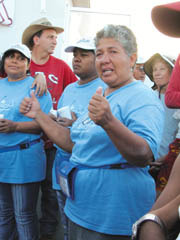
The homeowners
One of the most engaging things about working on a blitz build with HFHI and JCWP is the opportunity to make new friends. Whether starting out a doctor, fire fighter or janitor, everyone on this worksite is a construction worker. There is no race, religion nor creed. Nobody is rich; nobody is poor. Men and women are truly equal on this job. Everyone is a full partner in the construction of the home, including the homeowners.House 19 is now the home of Mrs. Virginia Reyes, along with two of her daughters and her three-month-old granddaughter. Virginia was married for 19 years and had four children when her husband left. That was 15 years ago. Virginia is now the grandmother of nine and has a successful enterprise selling prepared foods, primarily in her home village of Cochindi. Cochindi is roughly an hour and a half away by bus from her new home in Veracruz. She has some clients in Veracruz, but will continue to commute two days a week to serve her hometown clients.
Virginia is number 11 of 15 children. The home she grew up in consisted of one bedroom for mom and dad, one for the boys, and one for the girls. Two of her brothers still live in the old family homestead. Electricity and running water were added two years ago.
Virginia has successfully raised her four children, but prior to the opportunity to work in partnership with HFH Mexico, she has never owned a home of her own. Virginia and her brother Armenio were the first to show up for work and the last to leave the job every day. This week of work followed months that all the homeowner families had already worked in preparation for the JCWP blitz build. There was a pre-build group from HFH Mexico and HFHI who came to lay out and organize the build. Homeowners provided much of the labor that went into preparing the site, digging in the foundations, and laying the first courses of block. Without Virginia's experience laying block, it is doubtful her own home would have been built on time!
Like all Habitat homeowners, Virginia will now pay back the mortgage. She will pay roughly the same per month as she did for a rented room in Veracruz. The space is greater in her new home, and facilities are roughly the same. According to Virginia, however, the key difference is: "It will be mine!"
